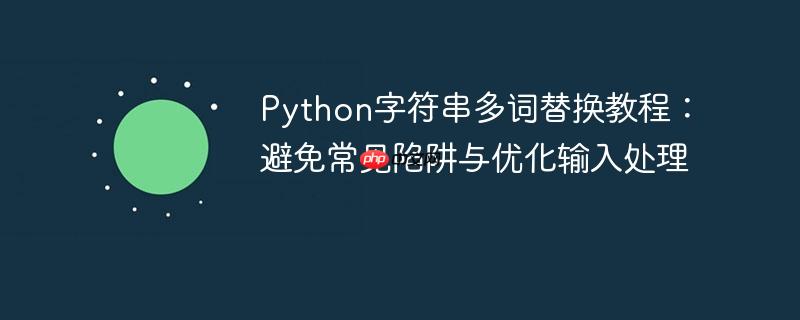
在文本处理中,我们经常需要根据一组预定义的替换规则,将句子中的多个词语替换为其他词语。例如,将“automobile”替换为“car”,将“children”替换为“kids”。这种需求的核心在于,如何确保所有的替换规则都能被正确且连续地应用到原始文本上。
初学者在实现多词替换时,常会遇到一个问题:只有最后一条替换规则生效,或者部分替换未能按预期执行。这通常是由于对str.replace()方法的返回值处理不当造成的。
考虑以下代码示例:
words = input("请输入替换词对(例如:old1 new1 old2 new2):")
word_pairs = words.split(' ') # 使用三个空格作为分隔符
replacement_words = {}
# 将词对存入字典
for pair in word_pairs:
split_pair = pair.split(' ')
replacement_words[split_pair[0]] = split_pair[1]
sentence = input("请输入待替换的句子:")
# 错误的替换逻辑
for key, value in replacement_words.items():
new_sentence = sentence.replace(str(key), str(value))
print(new_sentence)当输入为 automobile car manufacturer maker children kids 和 The automobile manufacturer recommends car seats for children if the automobile doesn't already have one. 时,预期输出应为 The car maker recommends car seats for kids if the car doesn't already have one.。然而,上述代码的实际输出却是 The automobile manufacturer recommends car seats for kids if the automobile doesn't already have one.。
错误原因分析:
立即学习“Python免费学习笔记(深入)”;
问题出在循环内部的这一行:new_sentence = sentence.replace(str(key), str(value))。在每次循环迭代中,sentence变量始终引用的是原始的、未被修改过的句子。因此,每次调用replace()方法,都是基于原始句子进行替换,并将结果赋给new_sentence。这意味着,前一次迭代对new_sentence的修改会被后续迭代完全覆盖,最终new_sentence只保留了最后一次替换操作的结果。
要解决上述问题,关键在于确保每次替换操作都是基于上一次替换后的结果进行的。这意味着,我们需要在循环内部更新被替换的句子变量本身。
以下是修正后的代码实现:
words = input("请输入替换词对(例如:old1 new1 old2 new2):")
word_pairs = words.split(' ')
sentence = input("请输入待替换的句子:")
# 正确的替换逻辑:累进式更新 sentence
for pair in word_pairs:
split_pair = pair.split(' ')
old_word = split_pair[0]
new_word = split_pair[1]
sentence = sentence.replace(old_word, new_word) # 直接更新 sentence
print(sentence)通过将sentence = sentence.replace(old_word, new_word)放置在循环内部,每次替换都会作用于当前sentence的最新状态。这样,所有的替换操作就能按顺序累进地生效。
除了修正核心逻辑,我们还可以对代码进行一些优化,以提高其简洁性和用户体验。
结合这些优化,最终的代码如下:
# 1. 首先获取待处理的句子
sentence = input("请输入待替换的句子:")
# 2. 然后获取替换词对,并直接进行分割
# 例如:automobile car manufacturer maker children kids
word_pairs = input("请输入替换词对(例如:old1 new1 old2 new2):").split(' ')
# 3. 遍历词对并进行累进式替换
for pair in word_pairs:
split_pair = pair.split(' ')
old_word = split_pair[0]
new_word = split_pair[1]
sentence = sentence.replace(old_word, new_word)
print(sentence)示例运行:
输入:
请输入待替换的句子:The automobile manufacturer recommends car seats for children if the automobile doesn't already have one. 请输入替换词对(例如:old1 new1 old2 new2):automobile car manufacturer maker children kids
输出:
The car maker recommends car seats for kids if the car doesn't already have one.
通过本教程,我们学习了在Python中实现多词替换的正确方法,并深入理解了str.replace()方法在循环中使用的常见陷阱。关键在于确保每次替换操作都能累进地作用于字符串的当前状态。同时,通过优化输入处理流程,我们可以编写出更简洁、用户体验更好的代码。在实际应用中,还需要根据具体需求考虑大小写敏感性、整词匹配等高级替换场景,并适时利用正则表达式等更强大的工具。
以上就是Python字符串多词替换教程:避免常见陷阱与优化输入处理的详细内容,更多请关注php中文网其它相关文章!

每个人都需要一台速度更快、更稳定的 PC。随着时间的推移,垃圾文件、旧注册表数据和不必要的后台进程会占用资源并降低性能。幸运的是,许多工具可以让 Windows 保持平稳运行。

Copyright 2014-2025 https://www.php.cn/ All Rights Reserved | php.cn | 湘ICP备2023035733号